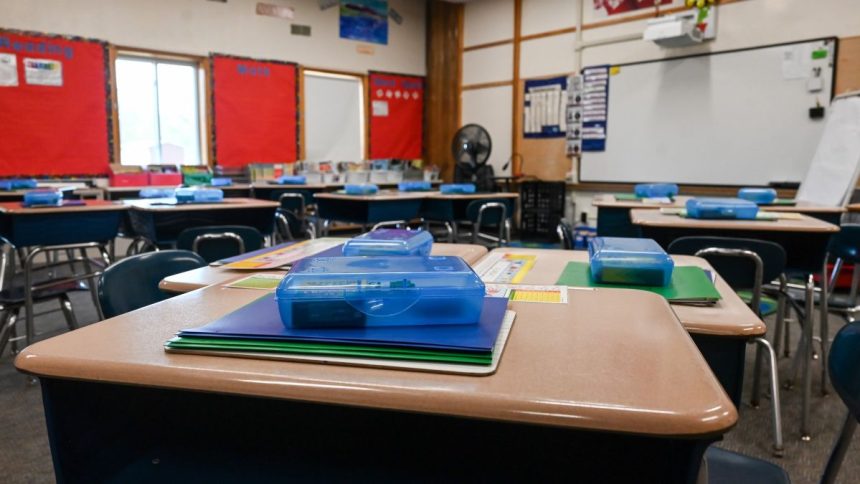In Bangor’s Downeast School, teachers are setting up for the upcoming year. Crayon boxes and name plates top small desks, signs spell out the ABC’s. In one classroom, a banner proclaims “All Are Welcome.”
Principal Sarah Vickers said the elementary school has been working toward better serving and including students who have disabilities for a few years. This has meant pushing for more collaboration across departments, developing more proactive responses to negative behavior in the classrooms, as well as planning lessons to serve a diverse array of needs.
Principal Sarah Vickers stands in a classroom at Downeast School in Bangor, one of three elementary schools taking part in the state’s inclusive education pilot. Photo by Kristian Moravec.
“We do have students that receive special education services for the majority of their day, and with these kinds of support and practices in place, we’ve been able to transition them to a less restrictive environment,” Vickers said.
“Being able to spend more time or the majority of their day in the regular (education) setting without additional supports, or supports being much less than what they previously had, has been a big success for us.”
About a third of the children at her school need special education services, according to state data.
This year, Downeast’s pursuit of more inclusive education is scaling up: it is one of three elementary schools that is working with the state and the University of Maine at Farmington as part of a five-year pilot program aimed at helping teachers learn how to incorporate students with various needs in their classrooms and move away from the silos that have long separated students with disabilities.
The other two schools are Turner and Leeds Central, both near Lewiston.
The program, which is supported through federal grant funding from the Individuals with Disabilities Education Act and through a partnership with the University of Maine, launches as special education costs are on the rise in Maine and as federal priorities are shifting.
The state Department of Education declined to say how much the program will cost. “We are unable to provide a specific dollar amount to you at this time,” wrote Erin Frazier, from the Office of Special Services and Inclusive Education, in an email, “as the project is in its infancy.”
In 2022, roughly 56 percent of Maine special education students spent most of their day in the general education classroom — 10 percent lower than the national average, according to state data and the National Center for Education Statistics. Since then, Maine’s inclusion rate has only risen by one percent.
Nationally, around 15 percent of students need special education services. In Maine, that figure is 21 percent, according to 2023 data from the National Center for Education Statistics. Maine is tied with New York and Pennsylvania for the second-highest rate, behind Puerto Rico.
As the special education student population has grown, so have the costs. A 2018 state task force looking at special education costs recommended that the state “remove barriers between special education and general education and develop an integrated, inclusive system in which special education and general education work collaboratively to deliver services to all students.”
Disability rights advocates have long railed against a siloed approach to education for students with disabilities, and some see the new pilot as a step in the right direction.
Atlee Reilly, with Disability Rights Maine, explained that the purpose of IDEA is to ultimately help students participate in the broader community, such as through employment, further education and more.
“We need to do it in integrated settings, because it doesn’t make any sense to prepare children in a segregated, kind of artificial, environment to live in a community,” Reilly said. “Why not just support them to live in their communities from the jump?”
Reducing barriers
The pilot program will pay for participating schools to get leadership and teacher training, and will help schools restructure their schedules so special education students have more time in the general classroom. The state saw just four applications for the three spots.
For Tracy Whitlock, a special services coordinator at the state’s Office of Special Services and Inclusive Education, it was important that the schools were invested in the work.
“We never want to come into a school and say ‘you’re going to do this,’ it needs to be something that educators are passionate about,” Whitlock said.
The goal is to develop a model of inclusive education that other schools could eventually adopt.
Kate MacLeod, an associate professor at the UMF, is spearheading the program’s professional development and data collecting process. The first year, she said, will focus on leadership training: taking stock of how students are currently being included in classrooms, how resources are used for education and forming a plan to improve.
Years two through five will then incorporate training for educators to adopt inclusive practices like Universal Design for Learning, a decades-old concept that involves creating multiple access points to a given topic. Other practices could include looking at adjusting schedules to have special education students remain in the general class during universal learning blocks, and receive one-on-one attention with special education staff during other hours of the day.
In the general classroom, MacLeod explained that universally designed lessons about a book, for instance, may include three groups: a small group for independent reading, a small group for audio reading, and a small group that reads with the teacher. Then a teacher will offer multiple ways for students to think about the text, such as writing a summary or sharing a response out loud.
“You’re going to reduce barriers for the most number of people possible from the beginning, and then you have to do less individual differentiation, or support,” MacLeod said. “So that’s the goal, and that’s what really great teaching can be.”
‘Every student benefits’
The three schools are hoping that the pilot program, by improving the variety of supports available in the general classroom, could decrease the number of students that need special education services.
Some advocates point to weaknesses in identifying students in earlier age groups, prompting a need to over-identify special education students in later ages, as a reason behind high identification rates in Maine.
A recent report released by the Maine Education Policy Research Institute (MEPRI) found that high rates of challenging behavior — that is, types of student behavior in class that was disruptive, dangerous, or did not meet teacher expectations and required additional attention — is a growing issue for schools.
“Persistent challenging student behavior can overburden administrative and education staff, lead to an increase in special education referrals, contribute to over-identification of students with behavioral disorders and be a critical factor in the ongoing teacher shortage,” the report states.
Carrie Woodcock, the executive director of the Maine Parent Federation, explained that how schools address challenging behavior is tied to the siloed structure of special education.
“A student with high behavior is the number one thing that will get them kicked out of a classroom and in a special education setting,” Woodcock said. “But likewise, students with specific learning disabilities who may have a reading or a math disability, they might be getting pulled out of the classroom for too much time to get specific instruction.”
But if classrooms use a more universal design for learning, Woodcock said that kids who are struggling can find more success, and students who may not have a specific disability could be helped too.
“We all learn differently,” Woodcock said. “When you do inclusion right and universal design of learning right, every student benefits.”
Outlook
Reilly, of Disability Rights Maine, said that the pilot’s approach marks a positive change, but the challenge will be scaling it across the state.
“I’m sure that, in the coming years, there will be discussions about school funding and things like that and how can we make it to where schools are rewarded for — financially and otherwise — for not shipping their kids off to segregated regional or private placements,” Reilly said. “If those things make financial sense for schools, then they’re more likely to do them.”
As special education costs continue to rise, so do other school costs in Maine, sparking broader debate over school funding. Administrators have called for changes to the state’s school funding model and towns upset at tax increases have attempted to leave school districts.

Educators at Downeast School will receive coaching and professional development over the next five years aimed at reducing the siloed nature of special education. Photo by Kristian Moravec.
Lawmakers and researchers have examined the cost of special education in an effort to preserve resources. Two bills that aimed to increase the state’s share of special education funding for school districts, L.D. 933 and L.D. 71, were introduced this session but ultimately died.
In MEPRI’s study of the state school funding model, researchers pointed to a need to explore other ways of calculating how special education funding responsibility is split between the state and towns. A possible model the Institute suggested could mean funding school districts based on the amount of need special education students have, according to reporting from The Portland Press Herald.
“The cost of sending that learner to a separate space — I call it a segregated space because it’s only for students with disabilities — away from their home, neighbor, school, to receive services that the district or school can’t provide is very costly in a lot of different ways,” MacLeod said.
She explained that districts will pay hefty tuition to send students away. The schools that students are sent to, called special purpose private schools, can cost districts hundreds of dollars per day.
Aside from being separated from their communities, some students have been subjected to controversial restraint and seclusion practices, in which children are forcibly removed from classrooms and physically restrained in emergencies. Lawmakers passed a bill this year, L.D. 1248, that weakened previous rules on how and when educators can restrain and seclude students.
Inclusive support, when implemented well, means that schools are more effective with their resources, MacLeod said. For instance, having a more tightly integrated team of educators might mean schools could get by with fewer staff members overall.
As the pilot gets underway, MacLeod said it builds on work that educators have already been striving to do.
“I think folks are hungry for this,” she said. “They can see that there are better ways for all learners.”









